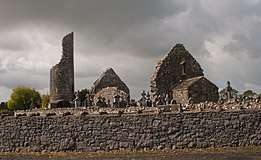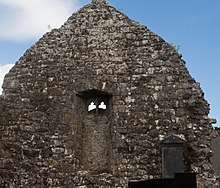Kilbennen
Kilbennen or Kilbannon is a medieval ecclesiastical site and National Monument located in County Galway, Ireland.[1][2]
Cill Bheanáin | |
 | |
 Location within Ireland | |
| Monastery information | |
|---|---|
| Other names | Kilbannon; Kilbennan; Cell-beneoin; Dun Lughaid |
| Order | Franciscans (15th century) |
| Established | late 5th century AD |
| Disestablished | 15th/16th century |
| Diocese | Tuam |
| People | |
| Founder(s) | Benignus of Armagh |
| Architecture | |
| Status | ruined |
| Style | Celtic |
| Site | |
| Location | Pollacorragune, Tuam, County Galway |
| Coordinates | 53.538801°N 8.892219°W |
| Visible remains | Church and round tower |
| Public access | yes |
National Monument of Ireland | |
| Official name | Kilbennen Church & Round Tower |
| Reference no. | 48 |
Location
Kilbennen is located 3.7 km (2.3 mi) northwest of Tuam, on the far side of the River Clare.[3]
History
The monastery here was founded by Benignus of Armagh (Benin, Benen, Bennan), a disciple of Saint Patrick,[4] in the 5th century AD, although the Book of Armagh associates it with a different Benignus, of the Luighne Connacht.[5] Iarlaithe mac Loga (Saint Jarlath) studied here in the 6th century.[6]
The Annals of the Four Masters record the burning of Kilbennen in 1114.[7] In 1148 they record the death of Ceallach Ua Domhnagain, "noble head of Cill-Beneoin."[8]
The Franciscans built a church c. 1428.[9]
Some conservation work was done in 1880–81.
Ruins and monuments


The limestone round tower is badly damaged and stands 16.5 m (54 ft) tall at its highest point and 4.8 m (16 ft) in diameter. It has a sandstone doorway 4.56 m (15.0 ft) off the ground.[10]
Both gables are standing on the church. The east gable had a twin-light cusped ogee-headed window.[11]
A holy well is located to the northwest, where Bennin is said to have healed nine lepers.[12]
References
- https://www.tripadvisor.ie/Attraction_Review-g211934-d8733467-Reviews-Kilbannon_Church_Ruins-Tuam_County_Galway_Western_Ireland.html
- MacNeill, Máire (1 January 2008). "The festival of Lughnasa: a study of the survival of the Celtic festival of the beginning of harvest". Comhairle Bhéaloideas Éireann – via Google Books.
- Association, Irish Tourist (8 April 2018). "Official Guide to Connacht". Irish Tourist Assoc – via Google Books.
- Ireland, Royal Society of Antiquaries of (8 April 2018). "The Journal of the Royal Society of Antiquaries of Ireland". The Society – via Google Books.
- "The Journal of the Royal Society of Antiquaries of Ireland". The Society. 8 April 2018 – via Google Books.
- "Kilbannon". dúchas.ie.
- "Part 22 of Annals of the Four Masters". celt.ucc.ie.
- "Part 25 of Annals of the Four Masters". celt.ucc.ie.
- "Great Britain and Ireland, a Phaidon Cultural Guide". Prentice-Hall. 8 April 1985 – via Google Books.
- Schorr, Frank. "Kilbennen Irish Round Tower". www.roundtowers.org.
- http://www.megalithicireland.com/Kilbennan%20%20Round%20Tower.html
- Bourke, Ulick Joseph (8 April 1876). The Aryan Origin of the Gaelic Race and Language: The Round Towers, the Brehon Law, Truth of the Pentateuch. Longmans, Green. p. 408 – via Internet Archive.
Kilbennen benignus.